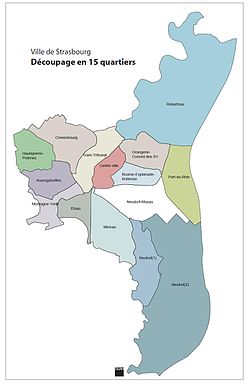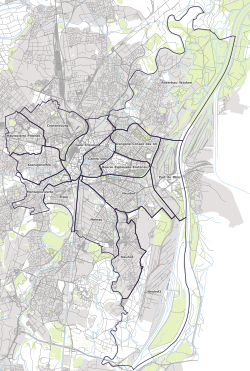Strasbourg
![]()
Strasbourg is a redirect to this article. For other meanings of Strasbourg and Strasbourg, see Strasbourg (disambiguation).
Template:Infobox commune in France/maintenance/alternate coat of arms in Wikidata
Strasbourg (French Strasbourg [stʁasbuʁ], in Strasbourg dialect Schdroosburi [ˈʃdɾoːsburi]) is a city in Alsace, a landscape in eastern France on the border with Germany. Strasbourg is the capital of the Bas-Rhin département, which has been a member of the European territorial community of Alsace since January 2021.
The city is the seat of the regional council and the regional prefect of the Grand Est region, as well as the capital of the Bas-Rhin prefecture. The prefecture also administers the arrondissement of Strasbourg, which consists of 33 municipalities. With 284,677 inhabitants (as of 1 January 2018) in the urban area and over 785,000 inhabitants in the agglomeration on French soil, Strasbourg is by far the largest city in the Grand Est.
Together with Basel (Bank for International Settlements), Geneva (ICRC as well as European UN headquarters) and New York City (global UN headquarters), Strasbourg is one of the few cities in the world to be the seat of one of the international organisations generally considered to be the most important, but without being the capital of a country. Strasbourg is the seat of numerous European institutions, including the Council of Europe, the European Parliament, the European Court of Human Rights, the European Ombudsman and the Eurocorps. Because of this, Strasbourg sees itself as the capital of Europe.
Parts of the city centre, the medieval old town on the Grande-Île and the New Town are UNESCO World Heritage Sites under the title Strasbourg: from the Grande-Île to the New Town, a European urban scene.
City name
The Roman predecessor settlement, which developed from a Celtic settlement, was called Argentorate, in Gallic Argento-, probably a river name, and -rate 'fortification'. Middle Latin name forms such as Argentoratum and Argentina are still found into the 16th/17th century (Frans Hogenberg, Matthäus Merian, Hartmann Schedel).
The name Strasbourg, first attested in 589, is composed of Old High German strāʒe 'army road' and Old High German burg 'fortified city' and thus means 'fortified place on the army road from Inner Gaul'. Early mentions are found in Gregory of Tours as ad Argentoratensem urbem quam nunc Strateburgum vocant (589) and Stradeburgum (590), in Nithard as Strazburg (842), and on Merovingian coins as Stradiburg and Stradeburgo. An alleged mention already around 400: [civitas Argentoratensium] id est Strateburgum is probably an addition from the time around 600.
Geography
Location and districts
The city is situated on the Ill River, which branches out in the urban area, at an altitude of 139 to 141 m above sea level. The historic old town is located on the Grande Île (Big Island), which is surrounded by both arms of the Ill. The eastern parts of the city with the harbour border on the Rhine. On the opposite eastern bank of the Rhine, on the German side, lies the town of Kehl. Both cities are connected by the Europabrücke (Europe Bridge) for road traffic as well as a railway bridge and a pedestrian bridge. Since 29 April 2017, there is also a tram connection between Strasbourg and Kehl: line D of the Strasbourg tram connects the town hall of Kehl with the centre of Strasbourg, crossing the Rhine over the Beatus Rhenanus Bridge. Strasbourg is the terminus of the Canal de la Marne au Rhin.
Strasbourg is divided into the following 14 districts (quartiers):
| District | number of inhabitants |
| Centre | 17.798 |
| Conseil des XV - Orangerie - Contades | 25.312 |
| Cronenbourg (German: Cronenburg) | 21.462 |
| Elsau | 06.000 |
| Esplanade - Bourse - Krutenau | 23.605 |
| Gare - Halles - Tribunal - Porte de Schirmeck | 24.000 |
| Hautepierre (German: Hohenstein) | 17.305 |
| Koenigshoffen (German: Königshofen) | 16.119 |
| Meinau | 16.627 |
| montagne verte | 12.149 |
| Neudorf - Musau - Port du Rhin | 40.706 |
| Neuhof | 19.658 |
| Poteries | 07.305 |
| Robertsau - Wacken - Cité de l'Ill | 19.557 |
Climate table
| Strasbourg | ||||||||||||||||||||||||||||||||||||||||||||||||
| Climate diagram | ||||||||||||||||||||||||||||||||||||||||||||||||
| ||||||||||||||||||||||||||||||||||||||||||||||||
| Monthly average temperatures and precipitation for Strasbourg
Source: wetterkontor.de | ||||||||||||||||||||||||||||||||||||||||||||||||||||||||||||||||||||||||||||||||||||||||||||||||||||||||||||||||||||||||||||||||||||||||||||||||||||||||||||||||||||||||||||||||||||||||||||||||||||||||||||||||||||||||||||||||||||||||||||||||||||||||||||
Questions and Answers
Q: What is Strasbourg?
A: Strasbourg is a city in eastern France.
Q: What is the population of Strasbourg?
A: About 275,000 people live in Strasbourg.
Q: What is the population of the metropolitan area of Strasbourg?
A: Around 780,000 people live in the metropolitan area of Strasbourg.
Q: Where is Strasbourg located?
A: Strasbourg is located on the left bank of the Rhine, opposite the German city of Kehl.
Q: What international organizations are based in Strasbourg?
A: Strasbourg is the seat of the Council of Europe, the European Court of Human Rights, and the European Parliament.
Q: Is Strasbourg considered to be the capital of the European Union?
A: Yes, a lot of people consider Strasbourg to be the capital of the European Union.
Q: What is the prefecture of Grand Est?
A: Strasbourg is the prefecture of Grand Est.
Search within the encyclopedia

